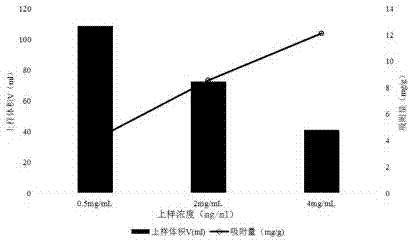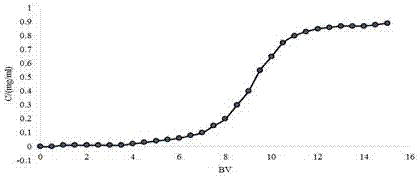Method for enriching 2-diabetes mellitus target inhibitor from liquorice residue and medical application
A type 2 diabetes, inhibitor technology, applied in pharmaceutical formulations, non-central analgesics, applications, etc., can solve the problem that the purity of total flavonoids of licorice cannot be guaranteed to be greater than or equal to 80%, and the content and activity of monomeric flavonoids are not measured. The data of licorice root is not clear, the composition of total flavonoid monomers of licorice is not clear, etc., to achieve the effect of protecting liver damage, simple and easy process operation, and inhibiting tumor growth.
- Summary
- Abstract
- Description
- Claims
- Application Information
AI Technical Summary
Problems solved by technology
Method used
Image
Examples
Embodiment 1
[0036] Example 1: Take an appropriate amount of licorice residue, add ethanol with a concentration of 70%, the ratio of solid to liquid is 1:30, extract at 90°C for 2 hours, extract 3 times, combine the extracts, and recover ethanol. Make the concentration of the licorice extract solution 4.0mg / mL, then pass through the macroporous resin: polyamide = 1:1 adsorption resin column at a flow rate of 1BV / h, stay for 12h after loading the sample, make it fully adsorbed, and use 5BV 50% Ethanol removes impurities at a flow rate of 2BV / h, then elutes 15 retention volumes with 80% ethanol at a flow rate of 3BV / h, recovers the eluate, and dries to obtain LRTF with a purity of 80% of the total extract content. Radix Glycyrrhizae The content of ketone A accounts for 10% of the total extract content. Using HPLC-MS to conduct ion fragment analysis to speculate its chemical composition, use various chromatographic separation and purification, and conduct physical and chemical constants and s...
Embodiment 2
[0038] Take an appropriate amount of licorice residue, add ethanol with a concentration of 70%, the ratio of solid to liquid is 1:30, extract at 90°C for 2 hours, extract 3 times, combine the extracts, and recover ethanol. Make the concentration of the licorice extract solution 4.0mg / mL, then pass through the macroporous resin:polyamide=5:1 adsorption resin column at a flow rate of 1BV / h, stay for 12h after loading the sample, make it fully adsorbed, and use 5BV 50% Ethanol removes impurities at a flow rate of 2BV / h, then elutes 15 retention volumes with 80% ethanol at a flow rate of 3BV / h, reclaims the eluate, and dries to obtain LRTF content that accounts for 85% of the total extract content. Radix Glycyrrhizae The content of ketone A accounts for 12% of the total extract content. Using HPLC-MS to conduct ion fragment analysis to speculate its chemical composition, use various chromatographic separation and purification, and conduct physical and chemical constants and spectr...
Embodiment 3
[0040] Take an appropriate amount of licorice residue, add ethanol with a concentration of 70%, the ratio of solid to liquid is 1:30, extract at 90°C for 2 hours, extract 3 times, combine the extracts, and recover ethanol. Make the concentration of the licorice extract solution 4.0mg / mL, then pass through the macroporous resin:polyamide=10:1 adsorption resin column at a flow rate of 1BV / h, stay for 12h after loading the sample, make it fully adsorbed, and use 5BV 50% Ethanol removes impurities at a flow rate of 2BV / h, then elutes 15 retention volumes with 80% ethanol at a flow rate of 3BV / h, recovers the eluate, and dries to obtain 90% of the total extract content with LRTF content. The content of ketone A accounts for 18% of the total extract content. Using HPLC-MS to conduct ion fragment analysis to speculate its chemical composition, use various chromatographic separation and purification, and carry out physical and chemical constants and spectral identification to clarify ...
PUM
 Login to View More
Login to View More Abstract
Description
Claims
Application Information
 Login to View More
Login to View More - R&D
- Intellectual Property
- Life Sciences
- Materials
- Tech Scout
- Unparalleled Data Quality
- Higher Quality Content
- 60% Fewer Hallucinations
Browse by: Latest US Patents, China's latest patents, Technical Efficacy Thesaurus, Application Domain, Technology Topic, Popular Technical Reports.
© 2025 PatSnap. All rights reserved.Legal|Privacy policy|Modern Slavery Act Transparency Statement|Sitemap|About US| Contact US: help@patsnap.com



